
Low bed trailers are perfect for transporting oversized or heavy loads, and they come in various configurations to suit different transport needs.
For example, some low bed trailers are designed with a fixed deck height, making them ideal for transporting equipment that requires a specific clearance height.
Others have a variable deck height, allowing for greater flexibility when transporting items of varying sizes.
Low bed trailers are often used for transporting heavy machinery, construction equipment, and even large vehicles, due to their ability to handle heavy loads.
These trailers can be customized with features like hydraulic systems, winches, and tie-downs to secure loads during transport.
What is a Low Bed Trailer
A low bed trailer is a type of trailer that has a lower deck height than a standard trailer, typically ranging from 4 to 6 feet above the ground. This design allows for easier loading and unloading of oversized or heavy loads.
Low bed trailers often have a flat deck with no sides or a minimal side rail, which provides a clear path for loading and unloading equipment. They can be used for a variety of applications, including hauling construction equipment and transporting large machinery.

The deck height of a low bed trailer is typically lower than 6 feet, which is important for navigating low-clearance areas such as bridges and tunnels. This is especially useful for transporting oversized loads through areas with limited clearance.
Low bed trailers can be configured in various lengths and widths to accommodate different types of loads and equipment. They are often used in industries such as construction, mining, and manufacturing.
Loading and Cargo
Loading and cargo is a crucial aspect of low bed trailers. There are three primary methods for loading cargos on top of low bed trailers: rear ramp loading, side-loading, and front-loading.
Rear ramp loading requires a fixed neck at the front and a climbing ramp at the rear of the trailer, which can be challenging for construction machines. The height of the rear loading ramp increases risks during the loading and unloading process.
Side-loading is not a practical solution in most scenarios due to the need for a wide-open yard. However, if goods are on a platform near the height of the trailer's deck, this method can be effective.
Check this out: Cargo Trailers for Bikes
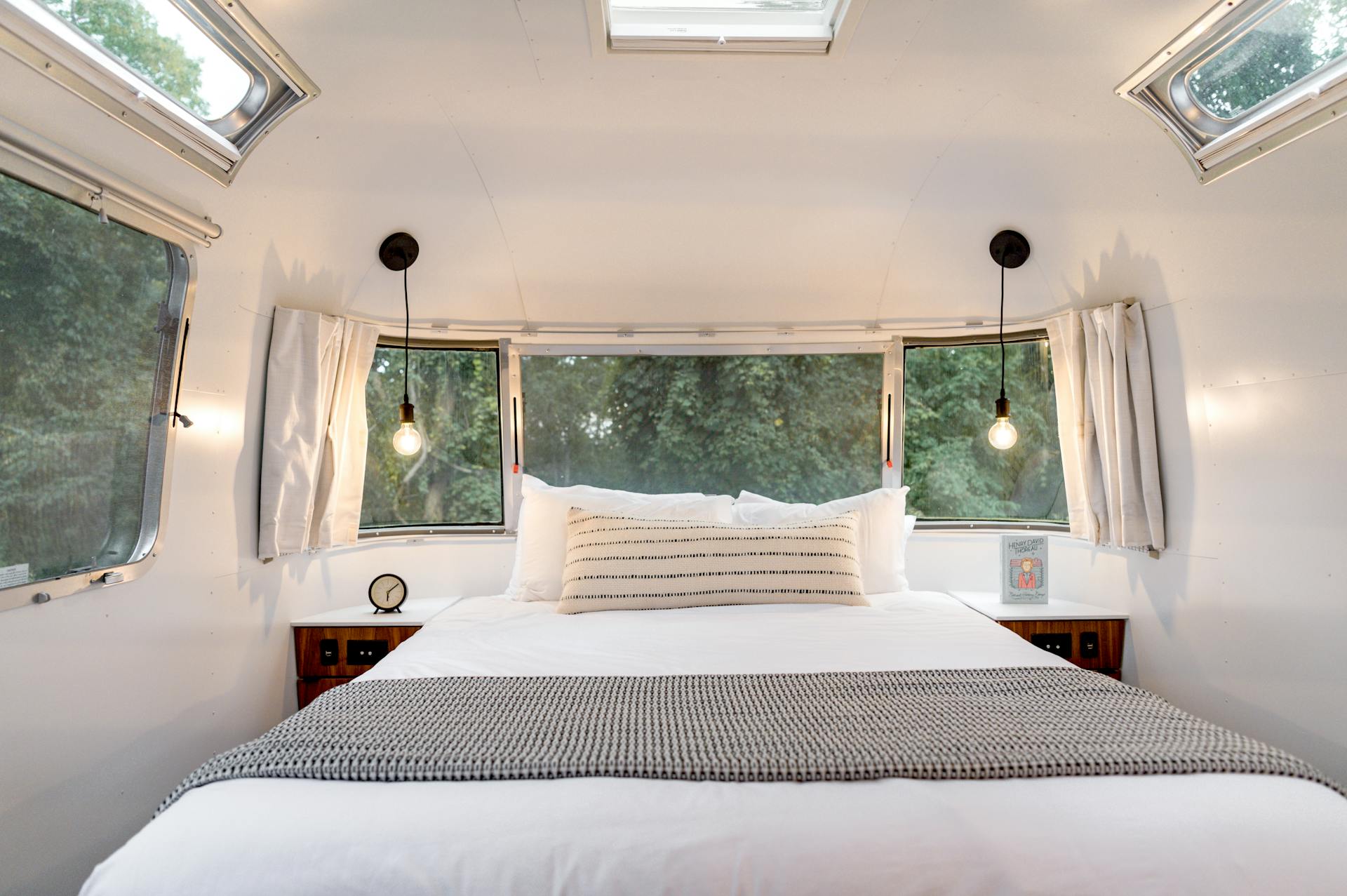
Front-loading is the most efficient way for cargos loading and unloading, especially with detachable goosenecks that allow construction machines to climb up and down freely.
Here's a comparison of the three loading methods:
How to Load Cargos Ontop
Loading cargos on top of lowbed trailers can be a bit tricky, but don't worry, I've got you covered. The most efficient way to load cargos is by using a detachable gooseneck, which allows construction machines to climb up and down freely.
There are three main methods to load cargos: rear ramp loading, side-loading, and front-loading. Rear ramp loading requires a very long ramp, which can increase risks during the loading and unloading process.
Side-loading is not always feasible, as it requires a wide-open yard for loading, which is hard to achieve in most scenarios. If goods are on a platform, and the height of the platform is near the height of the trailer's deck, this might be a good solution.
Curious to learn more? Check out: How Should You Transport a Load on a Flatbed Trailer
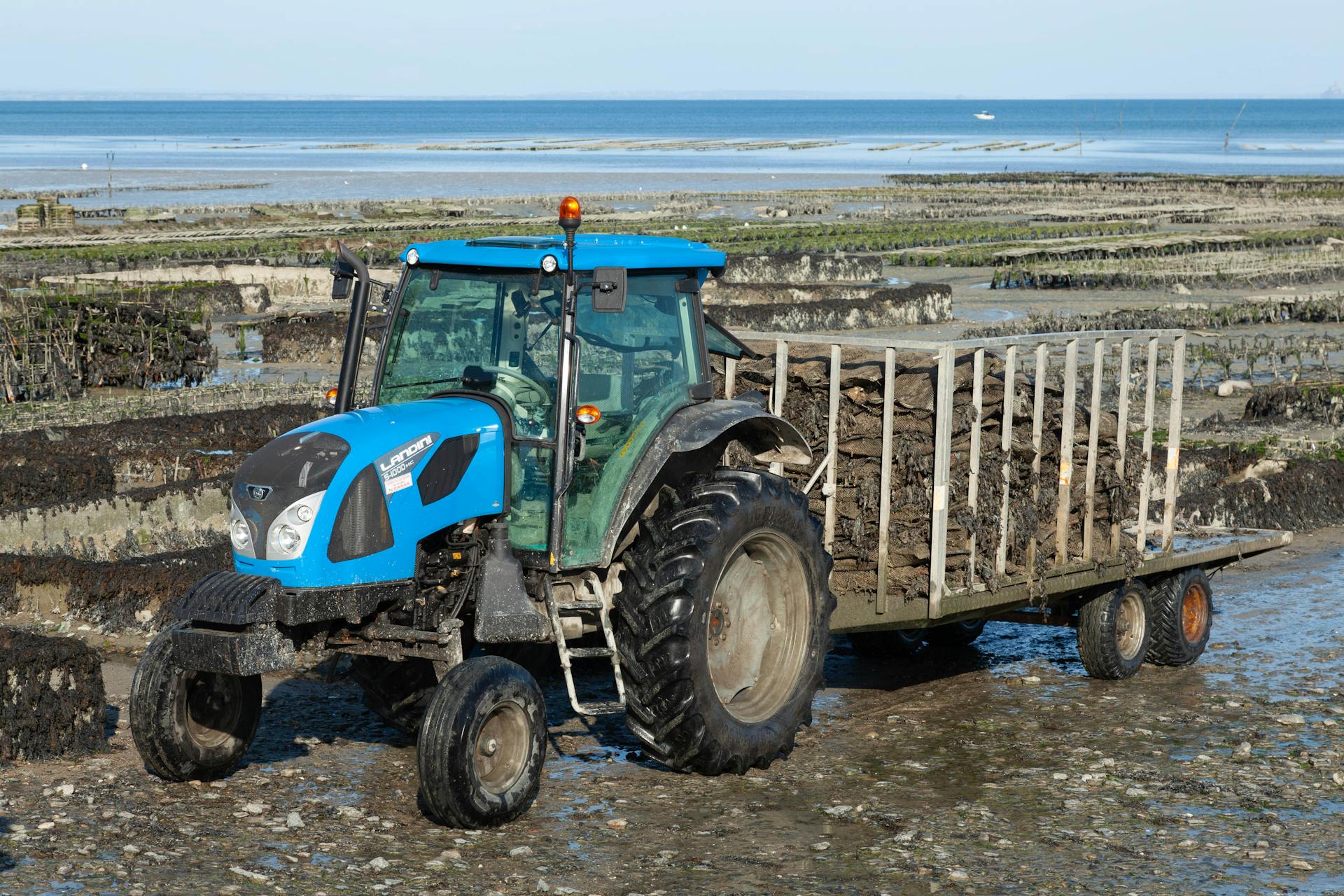
Front-loading is the most efficient way to load cargos, especially with detachable goosenecks that enable construction machines to climb up and down freely.
Here are the three loading methods in a nutshell:
By choosing the right loading method, you can ensure a safe and efficient cargo loading process.
Shipment Detail
Shipment Detail is a crucial aspect of loading and cargo. You can stack 3 axle low bed trailers on top of each other to reduce overall size and save on shipping costs.
This method allows for shipment via bulk cargo, RORO, or container vessel. It's a great way to transport multiple low bed trailers at once.
We take extra precautions to protect your low bed trailers during shipping. A waterproof tarp is applied, and wax is sprayed to prevent rust.
You can also opt to have the trailer placed inside the vessel for added protection. This is a great option if you want to ensure your trailer arrives safely.
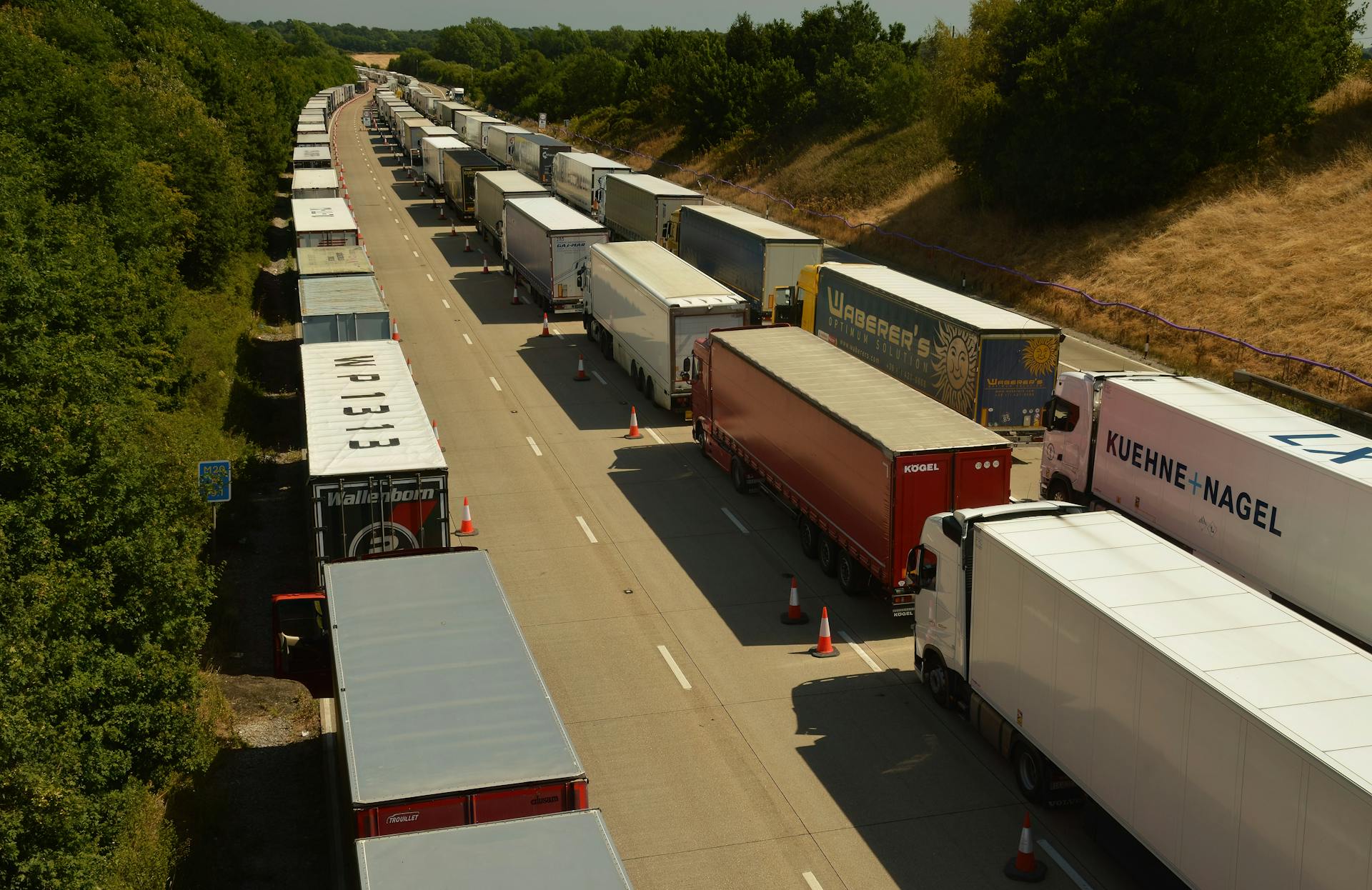
Insurance coverage is available for the low bed trailer during transit. This provides peace of mind and helps protect against potential damage or loss.
After the vessel leaves the China shipping port, we'll provide you with a website to track the boat's location. Updates will be provided every five days.
Here's a summary of the shipment details:
Specifications and Features
Low bed trailers come in various configurations, but they all share some key features. The mechanical or hydraulic climbing ramp is an option for easy loading and unloading, and the lower height of these trailers allows for easy maneuverability in tight spaces.
The loading capacity of lowboy trailers ranges from 30 to 150 tons, making them suitable for heavy-duty applications. The length and width dimensions of these trailers can also be customized to meet specific needs.
Some low bed trailers feature a drop deck design, which minimizes the trailer's platform height and increases trafficability and stability for over-height cargo. The top surface of the loading platform is often made of wood to prevent skidding, with optional diamond plate for added traction.
Features + Advantages

The DOLL low-bed trailer X is designed with reliability and payload-oriented design in mind. Its weight-optimised steel structure makes it a great option for heavy loads.
One of the standout features of the DOLL low-bed trailer X is its extraordinary ground clearance, even under extreme loads. This is made possible by its hydraulic suspension system.
The trailer also boasts outstanding manoeuvrability, thanks to its hydraulic axle steering developed by DOLL. This feature makes it easy to navigate tight spaces.
You can choose from three different axle technologies: DOLL panthe, DOLL vario, and DOLL tera. Each one has its own unique benefits and is designed to provide a smooth ride.
The DOLL tronic operating and control system is a user-friendly feature that makes it easy to operate the trailer. It also comes with the DOLL connect intelligent assistance system, which provides additional convenience.
Here are some key features of the DOLL low-bed trailer X:
- Deadweight: from 14,500 kg
- Payload: up to 50,000 kg
- Telescopic mechanism: 1 and 2-fold
- Loading height: 300 mm
- Number of axles: 1-4, hydraulically steered
- Suspension: Hydraulic suspension
- Chassis: 12 t swing axles with drum brakes
- Lift axles
- Wheelbase: 1,310 mm
The DOLL low-bed trailer X is also equipped with a range of load securing options, including trestles, stakes, and combination lashing strips. These features make it easy to secure your load and ensure a safe journey.
Hydraulic Ramp
A hydraulic ramp low bed trailer has 4 axles in 2 lines, with hydraulic folding ramps that can be adjusted sideways for different widths.
These ramps allow for flexibility when transporting construction machines of varying sizes.
All wheels on a hydraulic ramp trailer are steerable, which is a key feature for navigating tight spaces.
The spare tire rack is typically located on top of the gooseneck for easy access.
An electronic control panel on the trailer's neck provides convenient control over the hydraulic system.
Want to lower your overall traveling height even more than a mechanical suspension lowbed trailer? You need a hydraulic lowbed trailer with a girder beam set or a drop-deck, adjustable height.
Design and Production
The design of a low bed trailer is crucial for safe and efficient transportation of heavy equipment and oversized cargo. A key aspect of the design is the chassis frame, which should be as low as possible to accommodate large loads.
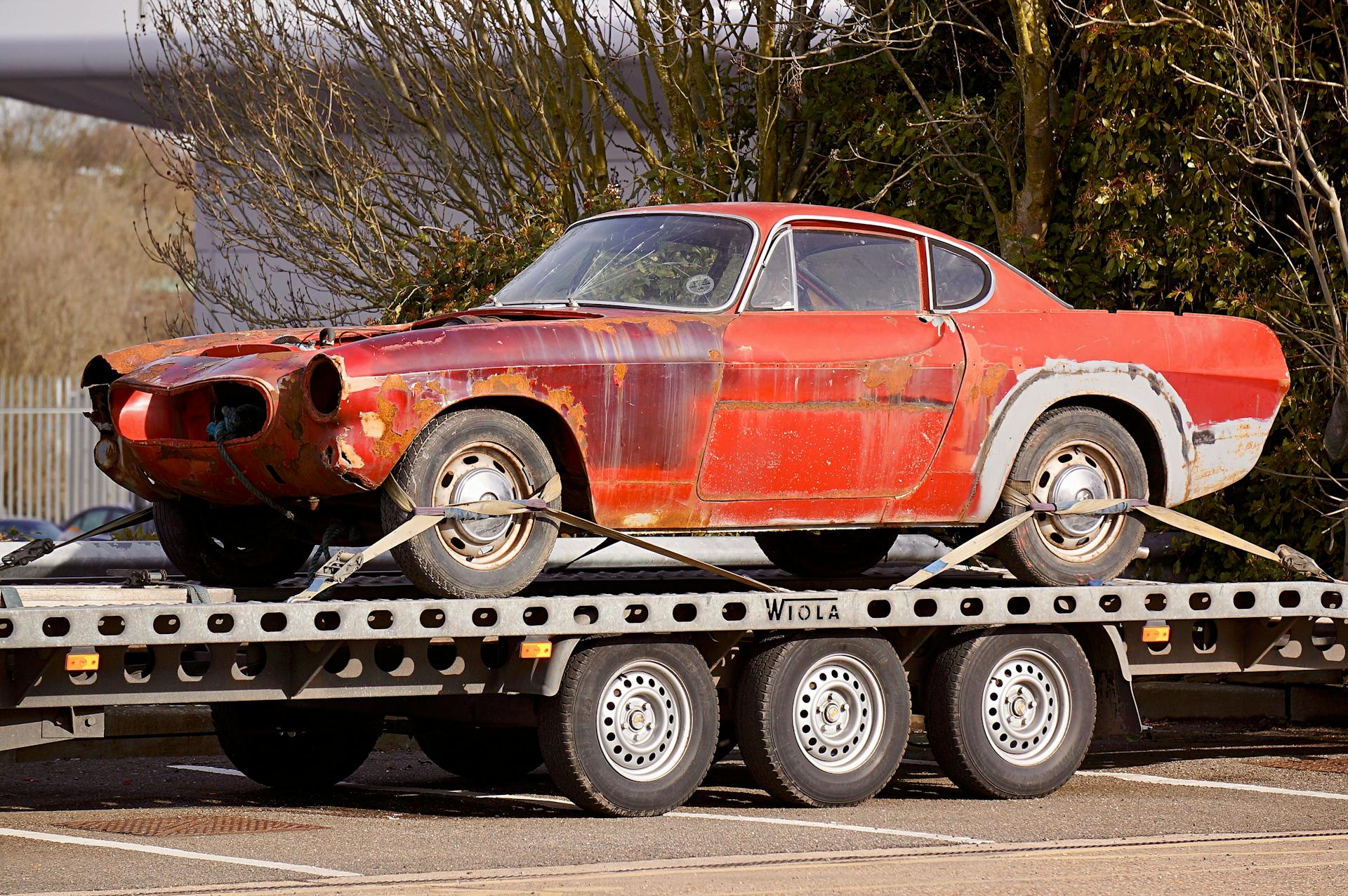
The main types of chassis frames used in low bed trailers are flatbed, gooseneck, and low drop-deck. Flatbeds are ideal for transporting steel materials, logs, and oversized equipment, while gooseneck trailers have a lower cargo platform than the top surface of the gooseneck. Low drop-deck trailers have a unique design where the gooseneck and rear part of the trailer are higher than the middle part.
In terms of production, manufacturers use advanced technologies to improve the quality and efficiency of the manufacturing process. Laser cutting technology, for example, can improve the precision of steel cutting, while automatic submerged arc welding can enhance the welding quality of the main beam. Shot blasting is also used to remove impurities from the surface of the trailer before painting, which improves the adhesion ability of the paint.
Worth a look: Gooseneck Trailer Transport
Steel Structure Design
The steel structure design of a lowboy trailer is crucial for safe and efficient transportation of heavy equipment. The chassis frame is the main loading steel structure, and its design is key to usability.
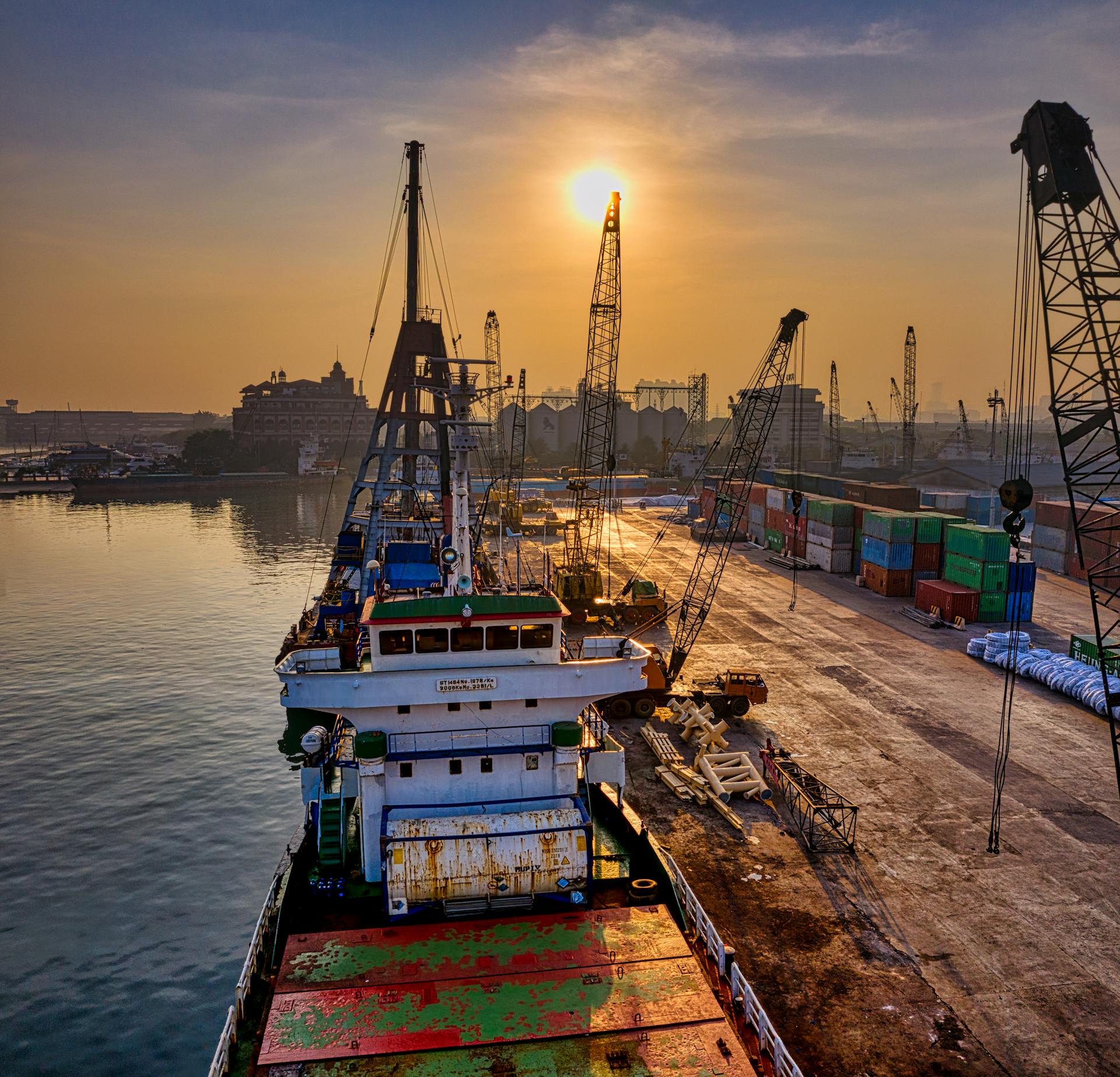
A flatbed type trailer has a flat cargo platform on top of tires, perfect for transporting steel materials, logs, and oversized equipment. The gooseneck type trailer has a lower cargo platform than the top surface of the gooseneck, making it ideal for transporting heavy machinery.
The low drop-deck type trailer has a unique design where the gooseneck and rear part of the trailer are higher than the middle part, allowing for loading of goods in a very low position. This design is particularly useful for transporting heavy equipment that requires a low clearance.
The future trend of chassis design is focused on creating lightweight, high-strength, and rigid structures. This is achieved through advanced materials and manufacturing techniques.
Here are the different types of chassis frame designs:
- Flatbed type: cargo platform is flat and on top of tires
- Gooseneck type: cargo platform is lower than the top surface of gooseneck
- Low drop-deck type: gooseneck and rear part of the trailer are higher than the middle part
3-Axle Design Detail
The 3-axle lowbed trailer design is all about functionality and safety. It features an open platform design with no fencing for easy loading and unloading.
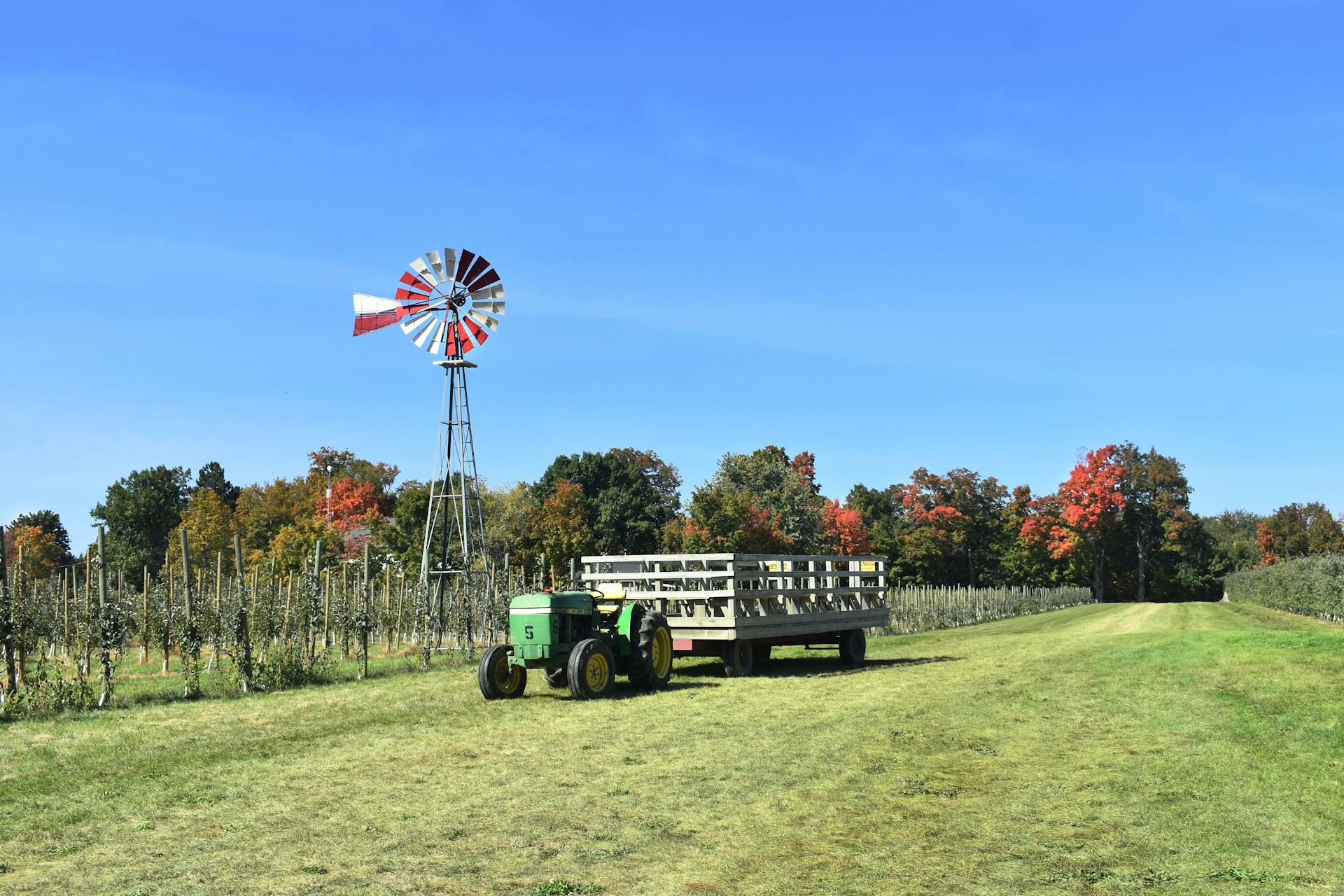
This design is perfect for transporting heavy equipment and oversized cargo. The open platform allows for smooth and efficient loading and unloading processes.
To further enhance transport efficiency, container locks are added to the bottom of the platform. This feature allows for the transportation of various types of containers.
Lower ramps are also included for easy loading and unloading at different heights. This is especially useful when dealing with goods that require specific height requirements.
For safe transport, the 3-axle lowbed trailer comes equipped with reflective signage, a lighting system, and a safety locking device. These features improve visibility and ensure the cargo remains stable and secure during transport.
Here are the key features of the 3-axle lowbed trailer design:
- Open platform design with no fencing
- Container locks for various types of containers
- Lower ramps for easy loading and unloading
- Reflective signage and lighting system for improved visibility
- Safety locking device for secure transport
Technical Data and Downloads
The technical data for low bed trailers is quite impressive. You can find low bed trailers with a deadweight ranging from 12,900 kg to 14,500 kg.
The payload capacity of these trailers varies as well, with some models able to carry up to 50,000 kg. The telescopic mechanism is another key feature, with single and double extension options available on some models.
Here is a summary of the technical data for the trailers:
The trailers also come with various load securing options, including trestles, stakes, and combination lashing strips.
Technical Data

The technical data for trailers can be overwhelming, but understanding the basics can make a big difference.
A typical low-bed trailer can have between 1 and 4 axles, with some models having hydraulically steered axles.
The payload capacity varies greatly, ranging from 13,000 kg to 50,000 kg.
Some trailers have a telescopic mechanism, allowing for single or double extension.
The suspension system can be either mechanical leaf spring or hydraulic suspension.
Here's a breakdown of the different types of trailers mentioned in the article sections:
The wheelbase length also varies between models, ranging from 1,310 mm to 1,360 mm.
The material used for the trailer's chassis can be either high-strength steel or a combination of materials.
Some trailers have a wide range of load securing options, including trestles, stakes, and combination lashing strips.
The operating and control system can be either DOLL tronic or DOLL connect trailer management system.
Downloads
Downloads are available for those who want to dive deeper into the technical data of our low loader trailers. You can find a range of documents to suit your needs.
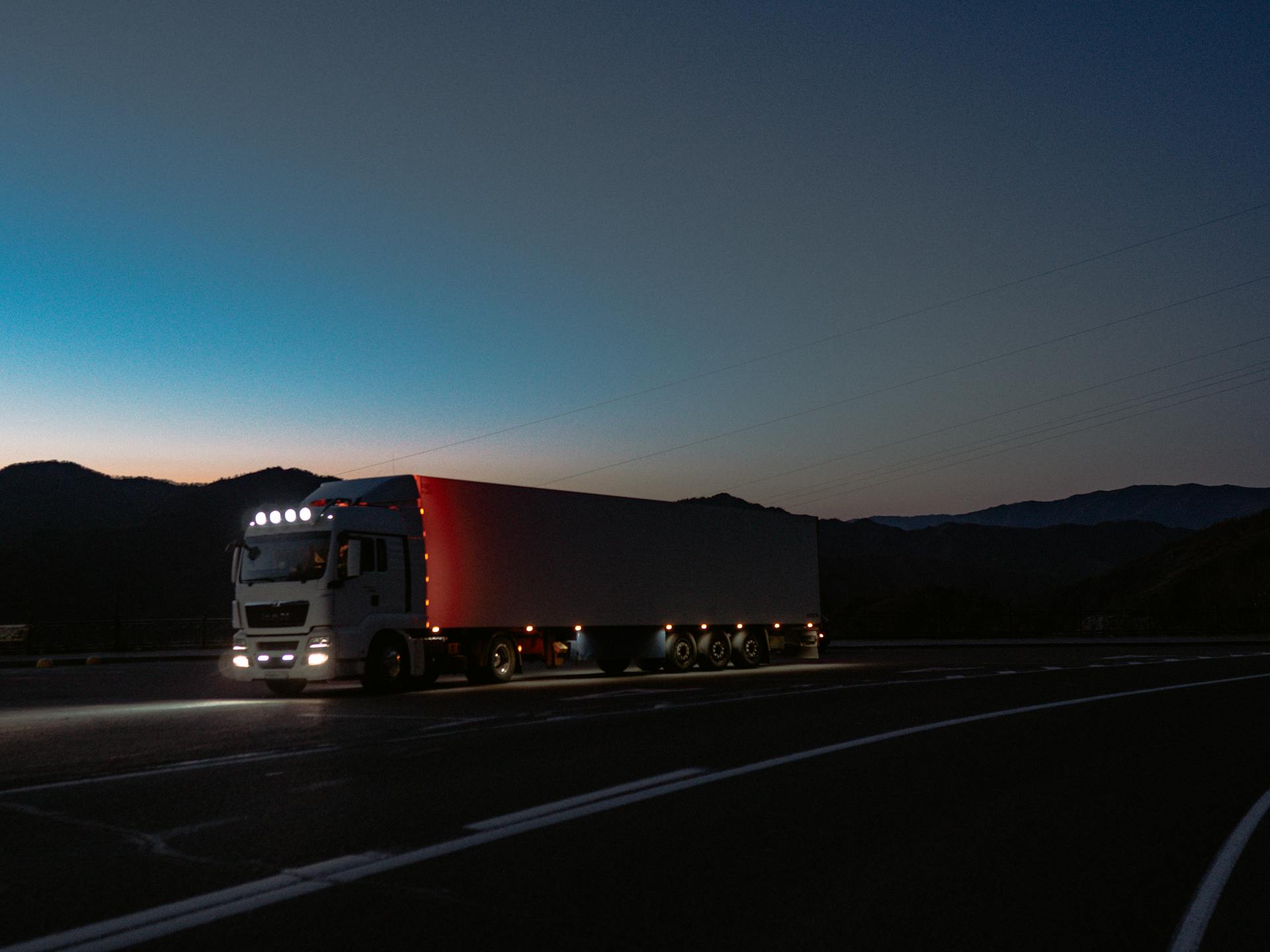
Our low loader brochure is a comprehensive PDF file that's 6 MB in size, providing a detailed overview of our products.
If you're interested in learning more about our 3 axle low loader trailer, we have a dedicated flyer available as a PDF file, weighing in at 5 MB.
We also offer a 4 axle low loader trailer flyer, another 6 MB PDF file that's packed with information.
For those who prefer a more concise format, our data sheet low loader trailer PDF is a compact 185 KB file that still delivers the essentials.
Here's a quick summary of our available downloads:
- Low loader brochure PDF (6 MB)
- Flyer 3 axle low loader trailer PDF (5 MB)
- Flyer 4 axle low loader trailer PDF (6 MB)
- Data sheet low loader trailer PDF (185 KB)
Custom Solutions and Safety
Nooteboom offers a wide range of low bed trailers that can be tailored to meet the specific needs of each customer. With a payload capacity of up to 150 tonnes, these trailers can handle even the heaviest loads.
The company's low bed trailers come in different combinations, including self-steering or hydraulically steering options, and can be equipped with various axles, suspension systems, and goosenecks. This flexibility allows customers to choose the perfect trailer for their transportation needs.
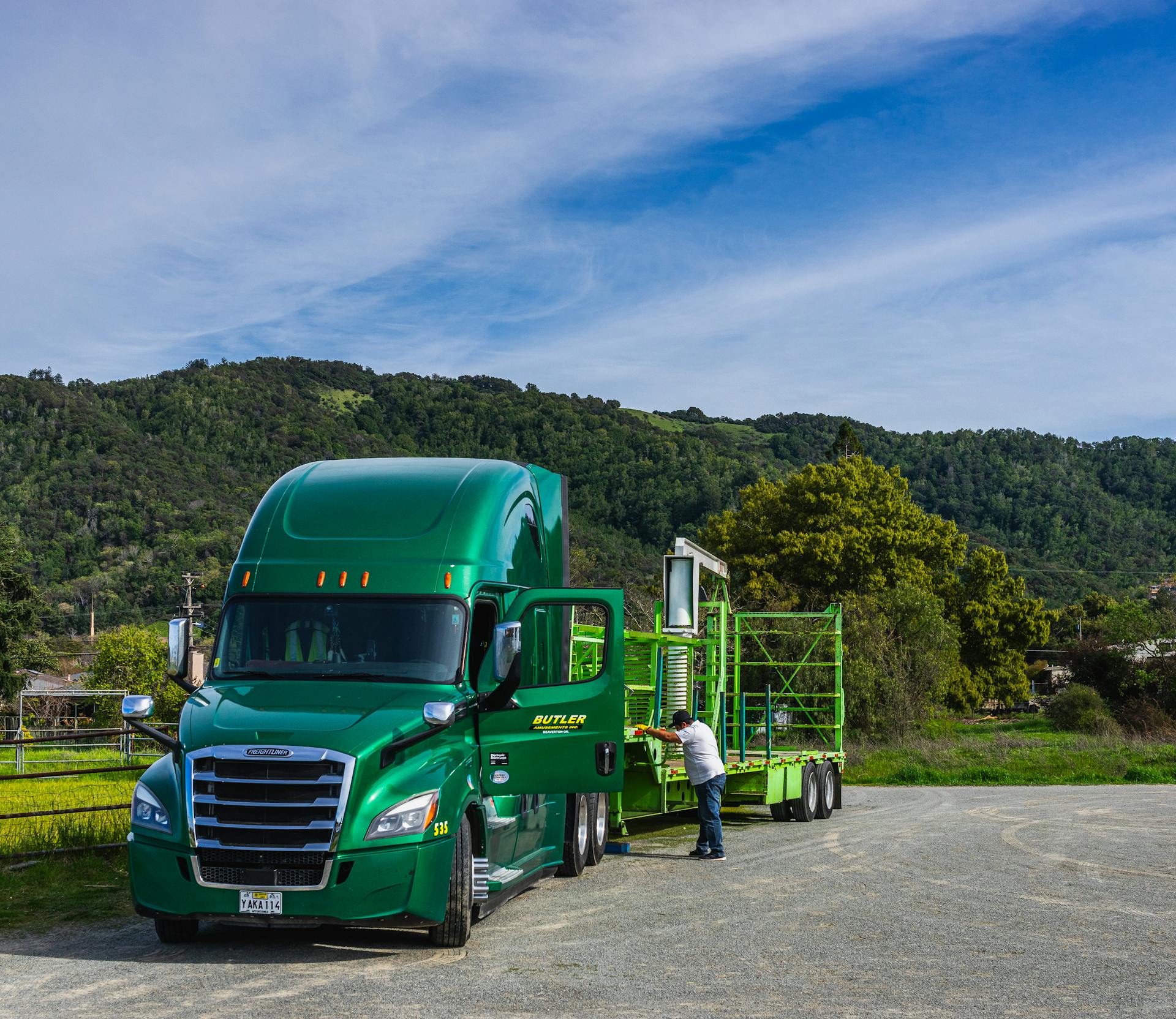
Some of the key features of Nooteboom's low bed trailers include fixed and hydraulic goosenecks, suitable for a variety of tractors, and a range of floor options, including fixed, single, double, and triple extendible floors. These features provide added safety and convenience for customers.
Here are some of the possible options for Nooteboom's low bed trailers:
- Self-steering or hydraulically steering low-loader
- With 2 to 9 axles or axle lines
- Hydropneumatic suspension or pendle axles
- Various fixed and hydraulic goosenecks, suitable for a variety of tractors
- Payload up to approx. 150 tonnes
- Fixed or single/double/triple extendible floor, with a wide range of versions and dimensions
Custom Solutions for Every Transport Need
Nooteboom offers a wide range of low bed trailers to meet different transport requirements, including self-steering or hydraulically steering low-loaders.
Their low bed trailers can be customized to suit various needs, with options such as 2 to 9 axles or axle lines, hydropneumatic suspension or pendle axles, and various fixed and hydraulic goosenecks.
You can choose from a variety of fixed or single/double/triple extendible floor options, with a wide range of versions and dimensions available.
The payload capacity of Nooteboom's low bed trailers can reach up to approximately 150 tonnes.

Here are some of the possible options for Nooteboom low bed trailers:
- Self-steering or hydraulically steering low-loader
- With 2 to 9 axles or axle lines
- Hydropneumatic suspension or pendle axles
- Various fixed and hydraulic goosenecks, suitable for a variety of tractors
- Payload up to approx. 150 tonnes
- Fixed or single/double/triple extendible floor, with a wide range of versions and dimensions
Added Safety and Ergonomics
The optimised multi-connector is a game-changer for safety and ergonomics. It allows for a more secure and stable setup.
Practical ramp storage areas are a must-have for any custom solution. They keep the workspace clutter-free and make it easier to access the ramp when needed.
Slip-proof rungs on the gooseneck provide extra grip and prevent accidents. This is especially important in situations where the gooseneck is being used in a hurry.
Curious to learn more? Check out: Gooseneck Cargo Trailer
Transport Solutions
Nooteboom offers a wide range of low bed trailers to meet the requirements for your low-loader transport. They come in different combinations, including self-steering or hydraulically steering low-loaders.
The trailers are available with 2 to 9 axles or axle lines, providing flexibility for transporting heavy loads. Hydropneumatic suspension or pendle axles can be chosen to suit specific needs.
Payloads can reach up to approximately 150 tonnes, making them suitable for heavy forestry and agricultural machinery. Various fixed and hydraulic goosenecks are available for different tractors.
Here are some key features of the Nooteboom low bed trailers:
- Self-steering or hydraulically steering low-loader
- 2 to 9 axles or axle lines
- Hydropneumatic suspension or pendle axles
- Various fixed and hydraulic goosenecks
- Payload up to 150 tonnes
The MANOOVR MPL semi low-loaders are exceptional due to their floor height of 780mm and at least 12 tonnes per axle line, making them suitable for international transport.
Models and Variants
Low bed trailers come in a variety of models and variants to suit different needs and industries.
The most common models are the standard low bed trailer, the step deck trailer, and the double drop trailer. Each model has its own unique features and advantages.
The standard low bed trailer is ideal for hauling heavy equipment and machinery, with a maximum payload capacity of up to 50 tons. It's also available in different lengths and widths to accommodate various cargo sizes.
Step deck trailers, on the other hand, are designed for hauling oversized loads, such as construction equipment and vehicles. They feature a raised deck and a lower deck for easy loading and unloading.
Double drop trailers are used for hauling long and heavy loads, such as pipes and beams. They have a lower deck height and a longer length to accommodate these types of cargo.
2-Ale Vario T2H-S3FS21
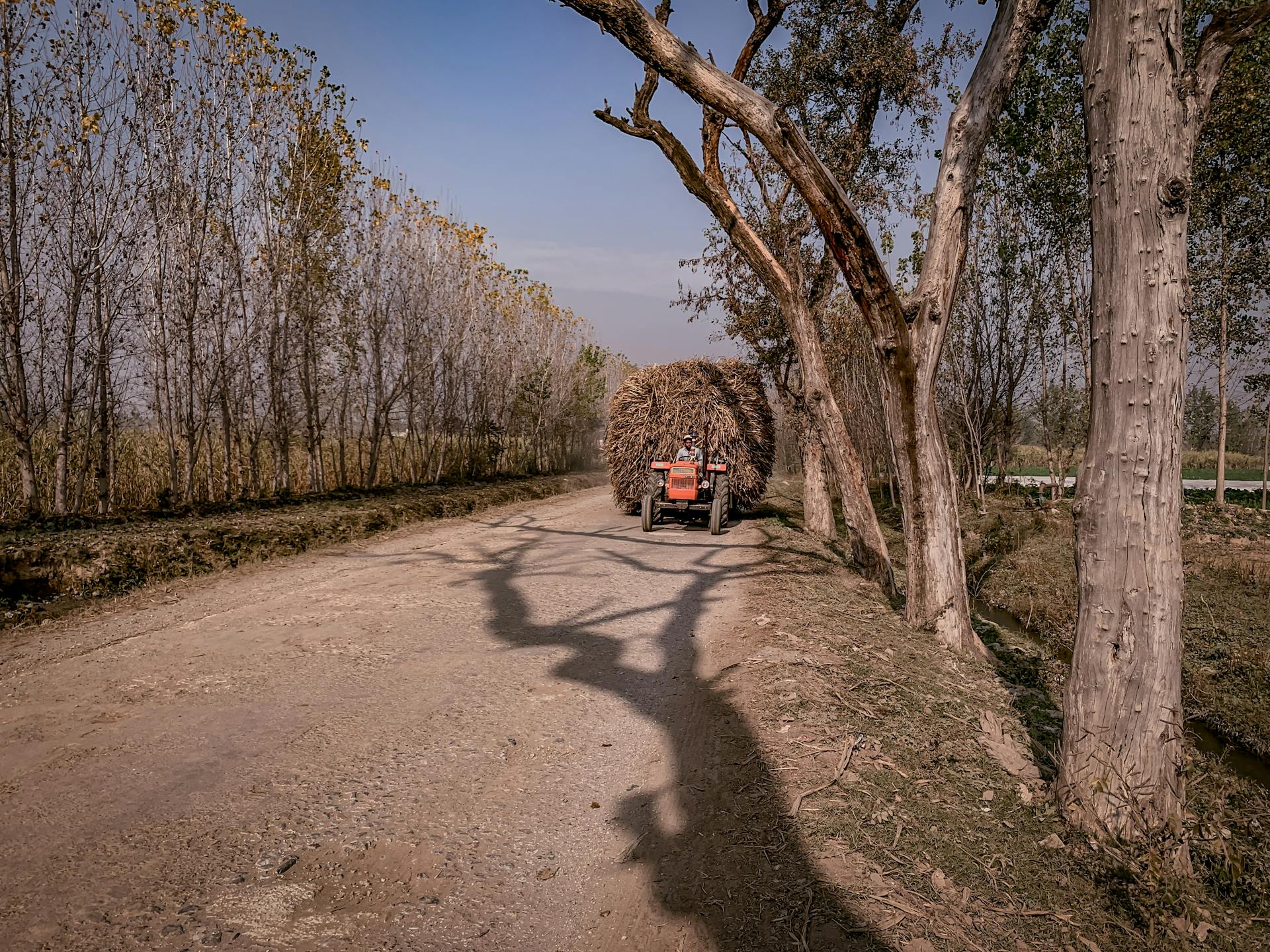
The 2-axle low-bed trailer X vario T2H-S3FS21 is a versatile option for hauling heavy loads. It features vario axle technology, which provides added stability and control.
This trailer is designed for heavy-duty use and can handle large and bulky items. Its vario axle technology allows for smooth and even weight distribution.
The T2H-S3FS21 is a specific model number that ensures compatibility with various vehicles and equipment. Its vario axle technology is a key feature that sets it apart from other trailers.
This trailer is ideal for industries that require frequent and heavy transportation of goods. Its vario axle technology makes it a reliable choice for businesses that rely on efficient logistics.
For your interest: Heavy Duty Cargo Trailer
3-Axle Panther T3E-S3FS25
The 3-Axle Panther T3E-S3FS25 is a low-bed trailer that features panther axle technology. This technology is designed to provide a stable and smooth ride.
This trailer is equipped with a robust chassis that can handle a payload of up to 40,000 kg. The deadweight of the trailer is from 13,100 kg.

The Panther T3E-S3FS25 has a wide range of load securing options available, including stakes, various tool and storage boxes, and combination lashing strips. These options ensure that your cargo is secure and safe during transportation.
The trailer is also equipped with a DOLL tronic operating and control system, which makes it easy to operate and control the trailer. Additionally, the trailer has a reverse camera, LED work lamps, and warning signs for increased safety and visibility.
Here are some key features of the 3-Axle Panther T3E-S3FS25:
3-Ale Vario T3H-S3FS25
The 3-Ale Vario T3H-S3FS25 is a robust and versatile low-bed trailer designed for heavy-duty applications. It features vario axle technology, which allows for optimal load distribution and stability.
The trailer has a number of axles, with the option to choose between two or three axles, all of which are hydraulically steered for easy maneuverability. The suspension is pneumatic, providing a smooth ride even on rough terrain.
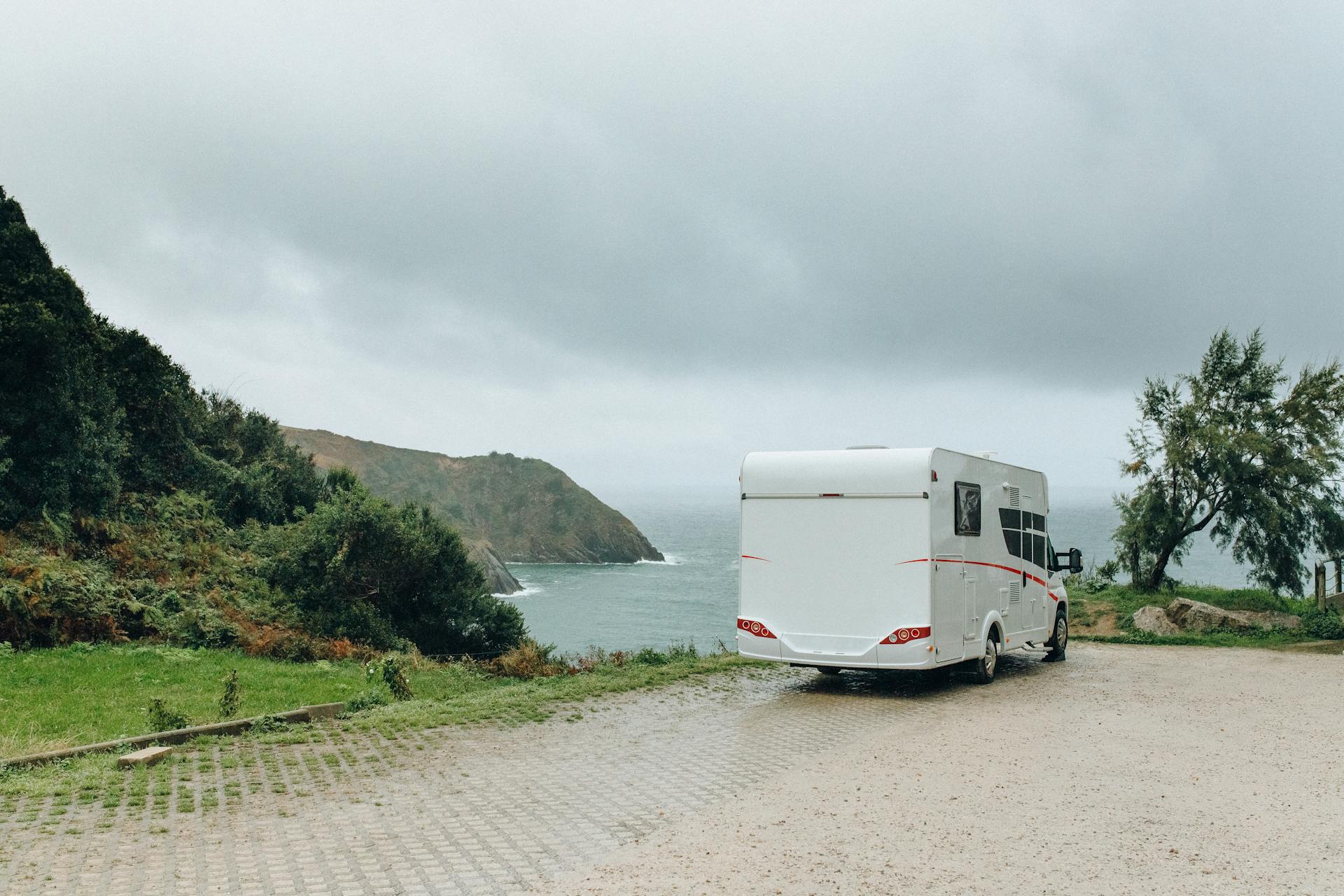
One of the standout features of the T3H-S3FS25 is its adjustable front wall, which can be designed in various heights and styles to suit different loads and applications. The trailer also comes equipped with platform gates and a tarpaulin structure on the gooseneck.
When it comes to load securing, the T3H-S3FS25 has a wide range of options available, including trestles, stakes, tool and storage boxes, and combination lashing strips. The trailer also features a stake storage area behind the front wall and a toolbox for added convenience.
The DOLL tronic operating and control system and DOLL connect trailer management system make it easy to monitor and control the trailer's functions. Additional safety features include warning signs, rear marking plates, LED work lamps, and a reverse camera.
A fresh viewpoint: Cargo Trailer Storage Ideas
Frequently Asked Questions
What is the difference between a flatbed and a low bed?
Flatbed trailers transport cargo, while low bed trailers are designed for construction machinery. Knowing the difference can help you choose the right trailer for your specific needs
What is the difference between lowboy and lowbed?
The main difference between lowboy and lowbed trailers is the height of the drop, with lowboy trailers featuring a more pronounced drop to accommodate taller loads. This design allows lowboy trailers to transport taller loads while adhering to height restrictions.
What is a semi-low bed trailer?
A semi-low bed trailer is a type of trailer with a low loading area, ideal for transporting tall or heavy loads. It offers a unique combination of space and accessibility for oversized or overweight cargo.
What size are lowbed trailers?
Lowbed trailers typically range from 40 to 59 feet in length, with options available for longer or shorter sizes depending on specific shipping needs.
Featured Images: pexels.com

